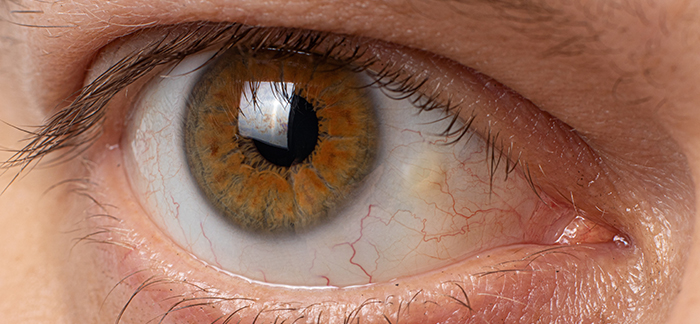
Although it sounds rather scary, a pinguecula (pronounced, ping-gweh-kyuh-luh) is a common age-related condition which is caused by the thickening of the conjunctiva, usually found close to the edge of the cornea.
What does a pinguecula look like?
A pinguecula is yellowish in colour and typically has a triangular shape. It’s a small raised patch that grows close to your cornea. Your cornea is the transparent layer that lies over your pupil and iris.
Pinguecula are more common on the side of your cornea closer to your nose, but they can also grow next to your cornea on the other side.
Symptoms of pinguecula

A pinguecula can make your eye feel irritated or dry. It can also feel like you have something in your eye, such as sand or other rough particles. The affected eye can itch or become red and inflamed. These symptoms of pinguecula can be mild or severe. Your Spec-Savers optometrist will be able to diagnose this condition based on the pinguecula’s appearance and location.
How is pinguecula diagnosed?
Your Spec-Savers optometrist can diagnose pinguecula through a normal eye examination. The optometrist will use a slit lamp to closely examine the growth. A slit lamp is a type of microscope that focuses a narrow line of bright light on your eye. It helps your provider look at the front and inside of your eye.
Is pinguecula serious?
Generally, pinguecula is harmless and is caused by unprotected exposure to sun, wind, and dust. Fortunately, pinguecula is not cancer and in most cases, it usually doesn’t cause pain or discomfort.
In most people, a pinguecula usually doesn’t need to be removed or treated. However, it is possible for the bump that a pinguecula creates on the eye’s surface to interfere with how the tear film is spread across the eye, which can lead to dry eyes, eye redness and irritation.
Can pinguecula cause blindness?
A pinguecula is a thickening to the conjunctiva – the protective surface of the eye – and so is unable to affect your vision. Pinguecula usually develops outside your central vision. It’s not impossible, but it usually doesn’t grow large enough to block your vision.
Treatment options for pinguecula

The majority of pinguecula cases don’t require any treatment. However, if you experience accompanying symptoms of dry eye syndrome, or it feels like there’s something in your eye, consult with your Spec-Savers optometrist for advice on how best to lubricate the eye. Only in the rarest of situations is a pinguecula surgically removed because it is a normal change of the eye’s surface.
Prevention of pinguecula
You can help prevent pinguecula from developing by wearing sunglasses with UV protection and a hat when you’re outdoors, especially if you spend a lot of time outdoors.
It is always advisable to visit your Spec-Savers optometrist when anything affecting your vision is in question. For patients with eye discomfort associated with a pinguecula, the most common treatment is artificial tears or ointments to provide more lubrication to the eye. This often helps to reduce the redness and irritation, in more severe cases, topical steroid drops may be used to control inflammation.
Date Published: 13 March 2023